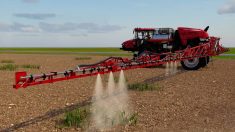Ethanol producers often get much of the blame for driving the price of corn to its current multi-year high levels due to that industry’s strong usage of corn to make fuel.
But critics overlook the growing production and distribution of dried distiller’s grains (DDGs), a byproduct of ethanol output used in animal feeds as an alternative to corn. Lax reporting of DDG sales and shipments make it hard to quantify the exact degree of corn displacement by DDGs, but with output projected to be more than 40 million short tons in 2011 – or the equivalent of over one billion bushels of corn – their supply contribution to the feed industry is substantial and worth tracking.
Read Also

Guarding against misinformation: Do you believe in house hippos?
Misinformation and disinformation run rampant in today’s digital age. Farmers must be wary of the digital dangers and know how to keep themselves safe.
Contrary to popular opinion, the ethanol-manufacturing process does not take corn out of the food stream entirely. It is estimated that between 15 and 18 pounds of DDGs are produced for every bushel of corn used to make ethanol.
In other words, between a quarter and a third of the corn crop’s matter re-emerges from the ethanol- manufacturing process as a nutrient-rich product highly suited for inclusion in animal-feeding rations.
Indeed, DDGs can contain higher protein and energy levels than traditional corn feed, and can cause fewer digestive issues because of lower starch content.
But the relative newness of DDGs as an abundantly available feed ingredient has meant that many feedlot managers have had very little experience in accommodating the product in large quantities. This has resulted in uneven uptake levels across the feeding industry.
That said, extensive studies have been conducted at U.S. university farm extension offices on the impact of varying quantities of DDGs in animal diets, and findings suggest that most feed rations can accommodate double-digit proportions of DDGs and deliver improved weight gain as well as improved economics while reducing expenses on corn feed.
This conservative approach to DDG uptake means the feeding industry has far from reached capacity in terms of DDG deman.
Shoddy bookkeeping, cautious buyers
The cautious behaviour of feedlot managers also reveals a demand for better quality-control metrics regarding DDG production and sale, as many batches of DDGs continue to be peddled by ethanol manufacturers as if they were a residual product from the ethanol process rather than as a key commodity in its own right with its own established market. This behaviour results in wide variations in the quality and consistency of the DDGs produced.
Much of the lack of quality control stems from a lack of general accounting as to the amount of DDGs produced in total. No single institution has taken ownership of reporting on the state of DDGs.
But recently, the USDA reported that it was reviewing how it “can better clarify the use of corn in ethanol production as reported in the balance sheet.”
“Accurately accounting for co-product use is complicated and imprecise. The degree to which corn co-products replace other feedstuffs is not clear. Various co-products have different uses and substitution rates in rations among species. The same applies at different stages of growth within species,” it added, revealing that discussions are underway to try to get a better handle on the extent to which corn co-products interact with corn grain the supply and demand arena.
GavinMaguireisaReuters marketanalyst.
———
Contrarytopopular opinion,theethanol manufacturingprocess doesnottakecornoutof thefoodstreamentirely.














